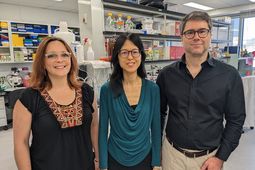Found: the mutated gene behind mirror movement disorder
- Salle de presse
05/15/2023
- UdeMNouvelles
In an advance that could pave the way for better diagnostics, Canadian scientists identify a new genetic mutation thought to cause the rare condition, which impairs coordination.
Scientists at Université de Montréal, McGill University and its affiliated Montreal Children's Hospital have made a promising breakthrough in understanding the origins of mirror movement disorder, a rare inherited neurological disorder.
The discovery was made by the team of Frédéric Charron, an UdeM medical professor and director of the molecular biology of neural development research unit at the Montreal Clinical Research Institute, working with Dr. Myriam Srour at the Children's.
Co-authored by postdoctoral fellow Dr. Sabrina Schlienger and research associate Dr. Patricia Yam, their study is published today in Science Advances.
Mirror movement disorder is an inherited neurological condition first manifested by involuntary movements, primarily in the arms and hands, at an early age. In those affected, the right hand involuntarily reproduces the movements of the left hand and vice versa, hence the term "mirror movement."
The disorder can cause pain in the arms during prolonged activities as well as difficulties in performing tasks requiring left-right coordination.
“Mirror movement disorder has a daily impact on the life of those affected," said Charron, who's also an associate professor at McGill. "In fact, the simple act of buttoning one's shirt or tying one's shoelaces can be challenging, as well as practicing certain sports or music instruments such as the piano."
Over the last 30 years, scientists have identified a group of genes called the Netrin signalling pathway that work together to attract neurons connecting the left and right sides of the brain to each other and to the spinal cord. This mechanism of neuronal guidance during embryonic development is essential for motor development.
Observing one affected family
The new study sheds light on a new genetic mutation that causes mirror movement disorder and incites its mechanism of action at the molecular level. Using a preclinical model, the researchers found that the mutation in a gene newly involved in the Netrin pathway results in abnormal movements, similar to those observed in the disorder.
The Canadian study is based on studying the genetics of a family whose members have carried the disease for more than four generations. The advance is good news for people with the condition who, until now, did not know which mutated gene was the cause, the scientists say.
Identifying the genes involved is an important first step towards rapid and effective diagnosis, they believe; understanding the mechanisms causing mirror movements is also essential in the search for innovative treatments, and could also help target other conditions caused by developmental defects of the nervous system.
“This is a great advance that considerably improves the state of scientific knowledge in our field of study and demonstrates the strength of combining clinical studies in human genetics with basic research," said Charron.
About this study
"Genetics of mirror movements identifies a multifunctional complex required for Netrin-1 guidance and lateralization of motor control," by Frédéric Charron et al, was published May 12, 2023 in Science Advances. Funding was provided by the Canadian Institutes of Health Research, the Neurobasis project of the Canada Foundation for Innovation, the Fonds de recherche du Québec - Santé, and the National Institutes of Health. Frédéric Charron holds the Canada Research Chair in Developmental Neurobiology.
Media contact
-
Florence Meney
IRCM
Tel: 514-987-5500, poste 5535 -
Jeff Heinrich
Université de Montréal
Tel: 514 343-7593














